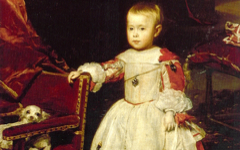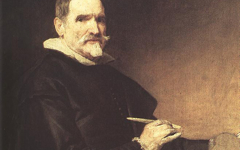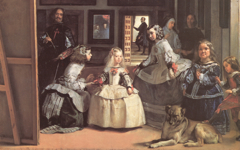Velazquez’s Prince Baltasar Carlos with a Dwarf (1632)

Velazquez, Portrait of Prince Baltasar Carlos and A Dwarf (1632) oil on canvas. Museum of Fine Arts, Boston
Click image to enlarge.
This, the first portrait Velazquez painted of an heir to the Spanish throne, is far more interesting than it has seemed. Analysts are right to note the contrast between the dwarf and the prince; the former twisting and shaded, the latter stiff, immobile and brightly lit with few shadows. Like the Count Duke of Olivares' in another portrait by Velazquez, the prince's outstretched arm may recall a painter's in front of a canvas. It rests, moreover, on a baton as does a painter's on a mahlstick. Dressed in armor as a metaphor for the creative struggle, the prince's other hand holds a sword, the iconic symbol in art for a paintbrush.
Click next thumbnail to continue
Jonathan Brown has observed how the rattle and apple in the dwarf's hands can on one level be seen as toys which the dwarf has taken away from the prince at the moment when this child became the heir-apparent. The toys' similarity of form to an orb and scepter conveys, in his opinion, "the difficult choice between pleasure and duty" which the child will one day face.1 There is, though, a third reading related to subjects more dear to a visual poet than the history and politics favored by the king.
Click next thumbnail to continue
Although the dwarf is the largest figure in the composition, the prince seems completely unaware of him. He stares off into the distance. Despite clear similarity between their figures (seldom noted) with their short, stuffed sleeves, there is great difference too. The dwarf, unlike the prince, seems alive. He twists his head in an over-the-shoulder pose common to artists turning to look at their model and his head is shaded as though in a completely different light. The carpet, meanwhile, slants upwards fitting the prince's figure firmly in position while leaving the dwarf floating over an ambiguous space. The two figures are indeed in different realities: the prince is "painted" on a canvas with the dwarf as the "artist" in front of it.
Click next thumbnail to continue

Manet, Mlle V. in the Costume of an Espada (1862) Oil on canvas. Metropolitan Museum, New York
Click image to enlarge.
Edouard Manet, the great master of nineteenth-century Paris and an ardent admirer of Velazquez, must have seen a painting like Baltasar Carlos with a Dwarf before he constructed his own early masterpiece Mlle V. in the Costume of an Espada. As you can see in its own entry Manet used similar features in Mlle V, including the perspective of the floor for a very similar purpose.
Click next thumbnail to continue
Velazquez, the court painter, has imagined himself as the dwarf, a court entertainer, standing in front of his own painting of the prince. Dressed in armor like Rembrandt in a contemporaneous self-portrait, the painted prince resembles a perfected version of the dwarf, a mal-formed human being who through his art purifies his soul, now symbolized as the heir to the Spanish throne. Not only are infants (like Jesus) a common symbol for a re-born soul but kings, too, (like God as well) can represent their purity. By allowing the dwarf's figure to echo the prince's, Velazquez suggests that the process of conceiving a poetic painting can transform a worldly male mind (the dwarf) into a pure and androgynous one (the prince). The royal infant, then, in armor is represented as victorious over all struggles, creative ones included.
See note below
Years later in 1659 Velazquez composed a new portrait of another infant-heir to the throne, Portrait of Infante Felipe Prospero. You may want to see how he handled that one as well..
More Works by Velazquez
Keep an eye on the "errors" in art and you will find the solutions

Velazquez’s Portrait of Infante Felipe Prospero (1659)
Notes:
1. Brown, Velazquez: Painter and Courtier (Yale University Press) 1986, p. 83
Original Publication Date on EPPH: 02 Mar 2012. | Updated: 0. © Simon Abrahams. Articles on this site are the copyright of Simon Abrahams. To use copyrighted material in print or other media for purposes beyond 'fair use', you must obtain permission from the copyright owner. Websites may link to this page without permission (please do) but may not reproduce the material on their own site without crediting Simon Abrahams and EPPH.





